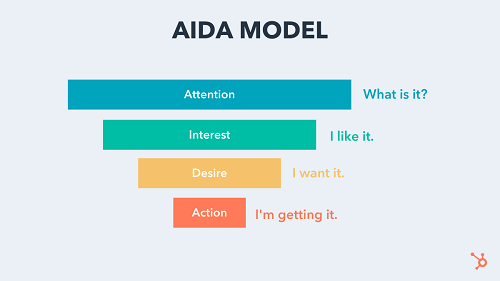Using The AIDA Model for SEO
 The AIDA model is one of the best ways you can use to rank better on Google. The AIDA model is a framework that gives you steps to rank better on Google. Plus, it has a basic SEO strategy that you can follow for your pages.
The AIDA model is one of the best ways you can use to rank better on Google. The AIDA model is a framework that gives you steps to rank better on Google. Plus, it has a basic SEO strategy that you can follow for your pages.
Many SEO experts have said that using the AIDA method has helped them generate leads, traffic and more conversions. This guide will take you through the AIDA basics and how to use them.
What is the AIDA Model?
AIDA is an acronym for Attention, Interest, Desire, Action. The technique is used mostly in copywriting to improve website content to rank better on search engines. Most webmasters use this technique because it provides a simple method of structuring content. We’ll expand on this concept below:
Attention
The first thing you need to do is grab your readers’ attention with interesting content. For example, this could be an interesting fact, story, or statistic. Some writers start with a shocking statement about a problem familiar to the reader. There are several ways to get the reader’s attention in written copy, these are:
- Urgency: Most people don’t like missing out on anything, and you can take advantage of this fact by using words that will spark awareness. For example, words like “breaking,” “important,” and “Alert” are used to get attention.
- Relevance: You need to ensure that the content is relevant to the reader. The best way to see whether the content is relevant to the reader is by doing keyword research.
- Personalization: A study from Statista revealed that personalized content gained 17.5% of clicks compared to 11.4% of content without personalization. This method is mostly used in emails.
- Curiosity: You can raise some curiosity by asking your readers a question. Alternatively, you can allude to an interesting story related to your product or service.
- Offers: Don’t be afraid to use words such as “free” or “promo” to get attention from your readers.
Interest
Once you have your readers’ attention, you can build interest. People need to be interested in what you’re selling at this stage. There are several ways to do this:
- Telling Stories: storytelling is a tried and tested method because it plays on people’s emotions. If people can relate to a story you told, they are most likely to continue engaging with the content.
- Please pay attention to Pain Points: people are constantly looking for solutions to their problems. Your job is to make it easier for them to find that solution. So, you can use emotive words and phrases to target people’s pain points. You can take it a step further by letting them know that you have the solution to their problems.
- Use Humor: Humor is another tactic that draws people in. Studies have shown that people often remember content when a funny story is involved. Plus, if the content makes a reader smile, it can create brand trust.
- Include Facts: using facts is one of the ways that help establish trust and authority. You can use an interesting fact or thought-provoking statistic to get readers interested.
Desire
At this stage, you need to empower your readers to act on the offer you’ve made. You have to create a desire for your product or service. So, you don’t have to preach to them about the product but highlight their benefits. You have to sell the product or service’s benefits, not the features.
Let’s say you’re promoting a webinar on writing blog posts. Instead of saying, “this webinar will show you how to write a blog,” you could lead with a question. For example, “are you struggling to write engaging blog posts? Learn how to save time by re-using blog posts in our webinar.”
The second phrasing focuses more on solving the reader’s problem than the webinar itself. That’s how you create a desire for your product.
Action
The last part is to get your readers to solve the problems they have. This stage of the AIDA framework is in line with a call-to-action (CTA). This is where you give your readers instructions on where to click to get a solution to their problem.
Your CTA needs to be simple, brief, and visible to readers. The best CTAs are five words or less, and you don’t have to use “click here” to entice people. For example, you can use “claim bonus here,” “join our webinar,” “Order Now,” etc.
Measuring the AIDA Model
- The Attention Phase – helps you see which channels are driving traffic to your website. For example, you can look at impressions and CTRs to see if people are paying attention to your content.
- Interest Phase – you can measure your overall engagement on your website. For example, the number of visits you get during a certain period and the bounce rate. These metrics are important to see whether your content is relevant or not.
- Desire Phase – this phase can help you measure the size of your audience. Make sure that this phase is on track so that you’ll be able to drive people to the action phase.
- Action Phase – this phase will help you track your conversion rate. If all the other metrics are great but have a low conversion rate, you can see where the problem is.
AIDA Model: Overview
There are a lot of websites on the internet that are competing for the attention of readers. So, optimize your website for its intended audience to rank better on Google. The AIDA model will help you boost your rankings on Google. Plus, this model helps keep the audience’s attention using long-form content.



